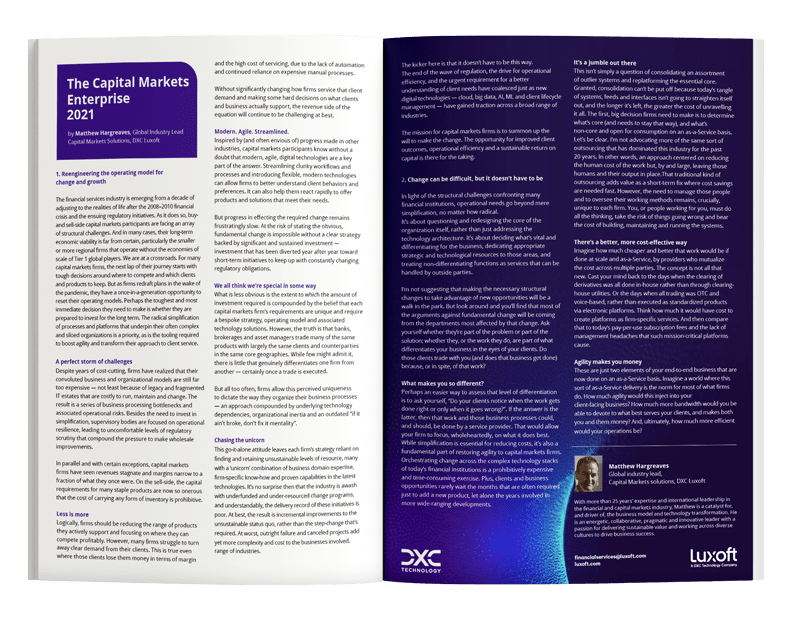by Matthew Hargreaves, Global Industry Lead Capital Markets Solutions, DXC Luxoft
1. Reengineering the operating model for change and growth
The financial services industry is emerging from a decade of adjusting to the realities of life after the 2008–2010 financial crisis and the ensuing regulatory initiatives. As it does so, buyand sell-side capital markets participants are facing an array of structural challenges. And in many cases, their long-term economic viability is far from certain, particularly the smaller or more regional firms that operate without the economies of scale of Tier 1 global players. We are at a crossroads. For many capital markets firms, the next lap of their journey starts with tough decisions around where to compete and which clients and products to keep. But as firms redraft plans in the wake of the pandemic, they have a once-in-a-generation opportunity to reset their operating models. Perhaps the toughest and most immediate decision they need to make is whether they are prepared to invest for the long term. The radical simplification of processes and platforms that underpin their often complex and siloed organizations is a priority, as is the tooling required to boost agility and transform their approach to client service.
A perfect storm of challenges
Despite years of cost-cutting, firms have realized that their convoluted business and organizational models are still far too expensive — not least because of legacy and fragmented IT estates that are costly to run, maintain and change. The result is a series of business processing bottlenecks and associated operational risks. Besides the need to invest in simplification, supervisory bodies are focused on operational resilience, leading to uncomfortable levels of regulatory scrutiny that compound the pressure to make wholesale improvements.
In parallel and with certain exceptions, capital markets firms have seen revenues stagnate and margins narrow to a fraction of what they once were. On the sell-side, the capital requirements for many staple products are now so onerous that the cost of carrying any form of inventory is prohibitive.
Less is more
Logically, firms should be reducing the range of products they actively support and focusing on where they can compete profitably. However, many firms struggle to turn away clear demand from their clients. This is true even where those clients lose them money in terms of margin and the high cost of servicing, due to the lack of automation and continued reliance on expensive manual processes. Without significantly changing how firms service that client demand and making some hard decisions on what clients and business actually support, the revenue side of the equation will continue to be challenging at best.
Modern. Agile. Streamlined.
Inspired by (and often envious of) progress made in other industries, capital markets participants know without a doubt that modern, agile, digital technologies are a key part of the answer. Streamlining clunky workflows and processes and introducing flexible, modern technologies can allow firms to better understand client behaviors and preferences. It can also help them react rapidly to offer products and solutions that meet their needs.
But progress in effecting the required change remains frustratingly slow. At the risk of stating the obvious, fundamental change is impossible without a clear strategy backed by significant and sustained investment — investment that has been diverted year after year toward short-term initiatives to keep up with constantly changing regulatory obligations.
We all think we’re special in some way
What is less obvious is the extent to which the amount of investment required is compounded by the belief that each capital markets firm’s requirements are unique and require a bespoke strategy, operating model and associated technology solutions. However, the truth is that banks, brokerages and asset managers trade many of the same products with largely the same clients and counterparties in the same core geographies. While few might admit it, there is little that genuinely differentiates one firm from another — certainly once a trade is executed.
But all too often, firms allow this perceived uniqueness to dictate the way they organize their business processes — an approach compounded by underlying technology dependencies, organizational inertia and an outdated “if it ain’t broke, don’t fix it mentality”.
Chasing the unicorn
This go-it-alone attitude leaves each firm’s strategy reliant on finding and retaining unsustainable levels of resource, many with a ‘unicorn’ combination of business domain expertise, firm-specific know-how and proven capabilities in the latest technologies. It’s no surprise then that the industry is awash with underfunded and under-resourced change programs, and understandably, the delivery record of these initiatives is poor. At best, the result is incremental improvements to the unsustainable status quo, rather than the step-change that’s required. At worst, outright failure and canceled projects add yet more complexity and cost to the businesses involved. range of industries.
The kicker here is that it doesn’t have to be this way. The end of the wave of regulation, the drive for operational efficiency, and the urgent requirement for a better understanding of client needs have coalesced just as new digital technologies — cloud, big data, AI, ML and client lifecycle management — have gained traction across a broad range of industries. The mission for capital markets firms is to summon up the will to make the change. The opportunity for improved client outcomes, operational efficiency and a sustainable return on capital is there for the taking.
2. Change can be difficult, but it doesn’t have to be
In light of the structural challenges confronting many financial institutions, operational needs go beyond mere simplification, no matter how radical. It’s about questioning and redesigning the core of the organization itself, rather than just addressing the technology architecture. It’s about deciding what’s vital and differentiating for the business, dedicating appropriate strategic and technological resources to those areas, and treating non-differentiating functions as services that can be handled by outside parties.
I’m not suggesting that making the necessary structural changes to take advantage of new opportunities will be a walk in the park. But look around and you‘ll find that most of the arguments against fundamental change will be coming from the departments most affected by that change. Ask yourself whether they’re part of the problem or part of the solution; whether they, or the work they do, are part of what differentiates your business in the eyes of your clients. Do those clients trade with you (and does that business get done) because, or in spite, of that work?
What makes you so different?
Perhaps an easier way to assess that level of differentiation is to ask yourself, “Do your clients notice when the work gets done right or only when it goes wrong?”. If the answer is the latter, then that work and those business processes could, and should, be done by a service provider. That would allow your firm to focus, wholeheartedly, on what it does best. While simplification is essential for reducing costs, it’s also a fundamental part of restoring agility to capital markets firms. Orchestrating change across the complex technology stacks of today’s financial institutions is a prohibitively expensive and time-consuming exercise. Plus, clients and business opportunities rarely wait the months that are often required just to add a new product, let alone the years involved in more wide-ranging developments.
It’s a jumble out there
This isn’t simply a question of consolidating an assortment of outlier systems and replatforming the essential core. Granted, consolidation can’t be put off because today’s tangle of systems, feeds and interfaces isn’t going to straighten itself out, and the longer it’s left, the greater the cost of unravelling it all. The first, big decision firms need to make is to determine what’s core (and needs to stay that way), and what’s non-core and open for consumption on an as-a-Service basis. Let’s be clear. I’m not advocating more of the same sort of outsourcing that has dominated this industry for the past 20 years. In other words, an approach centered on reducing the human cost of the work but, by and large, leaving those humans and their output in place.That traditional kind of outsourcing adds value as a short-term fix where cost savings are needed fast. However, the need to manage those people and to oversee their working methods remains, crucially, unique to each firm. You, or people working for you, must do all the thinking, take the risk of things going wrong and bear the cost of building, maintaining and running the systems.
There’s a better, more cost-effective way
Imagine how much cheaper and better that work would be if done at scale and as-a-Service, by providers who mutualize the cost across multiple parties. The concept is not all that new. Cast your mind back to the days when the clearing of derivatives was all done in-house rather than through clearinghouse utilities. Or the days when all trading was OTC and voice-based, rather than executed as standardized products via electronic platforms. Think how much it would have cost to create platforms as firm-specific services. And then compare that to today’s pay-per-use subscription fees and the lack of management headaches that such mission-critical platforms cause.
Agility makes you money
These are just two elements of your end-to-end business that are now done on an as-a-Service basis. Imagine a world where this sort of as-a-Service delivery is the norm for most of what firms do. How much agility would this inject into your client-facing business? How much more bandwidth would you be able to devote to what best serves your clients, and makes both you and them money? And, ultimately, how much more efficient would your operations be?


Matthew Hargreaves
Global industry lead, Capital Markets solutions, DXC Luxoft
With more than 25 years’ expertise and international leadership in the financial and capital markets industry, Matthew is a catalyst for, and driver of, the business model and technology transformation. He is an energetic, collaborative, pragmatic and innovative leader with a passion for delivering sustainable value and working across diverse cultures to drive business success.
